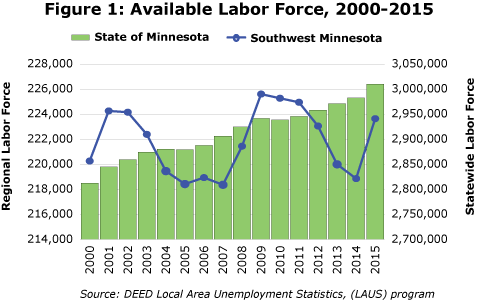
by Cameron Macht
June 2016
The 23-county region gained 4,800 workers in 2015, but the labor market remains tight.
Southwest Minnesota has experienced some substantial fluctuations in the size of the labor force over the last 15 years in response to changing economic conditions. During the recessions in both 2001 and 2007, workers – specifically mothers with children at home and minority workers – flooded into the region's labor market. But as the economy improved, the labor force shrank.
The region saw a steady decline of about 6,700 workers between 2009 and 2014, dropping the workforce back to pre-recession levels. Then Southwest's labor force saw an unexpected jump of 2.2 percent with the addition of almost 4,800 workers from 2014 to 2015.
The 23-county region is now home to almost 223,700 workers, about 2,000 below the peak recorded in 2009 and 3,400 above the regional labor force in 2000. This surge is even more notable because it occurred during a strong economy rather than in response to a recession (see Figure 1).

While the number of total workers and employed workers saw a big jump in the past year, the number of unemployed workers in Southwest Minnesota dropped to the lowest level reported since 2006, prior to the recession. The region is now home to just over 8,300 unemployed workers, yielding an unemployment rate of 3.7 percent in 2015. This has created a very tight labor market for employers who are seeking to fill jobs.
With 68.5 percent of the population ages 16 and over in the labor force, Southwest Minnesota has slightly lower labor force participation rates than the state's 70.1 percent rate. Known for a strong work ethic, the region actually has higher labor force participation rates than the state in all but one age group, but the overall rate is lower because a higher percentage of Southwest Minnesota's labor force is in the older age groups (see Table 1).
| Southwest Minnesota Employment Characteristics, 2014 | |||||
|---|---|---|---|---|---|
| - | Southwest Minnesota | Minnesota | |||
| - | In Labor Force | Labor Force Participation Rate | Unemployment Rate | Labor Force Participation Rate | Unemployment Rate |
| Total Labor Force | 215,393 | 68.5% | 4.9% | 70.1% | 6.5% |
| Employment Characteristics by Age Group | |||||
| 16 to 19 years | 12,765 | 56.2% | 14.1% | 51.1% | 18.7% |
| 20 to 24 years | 23,716 | 81.2% | 7.1% | 81.8% | 10.2% |
| 25 to 44 years | 80,057 | 89.2% | 4.9% | 88.1% | 5.8% |
| 45 to 54 years | 47,075 | 88.3% | 3.2% | 87.3% | 5.0% |
| 55 to 64 years | 39,814 | 77.1% | 3.1% | 71.8% | 4.9% |
| 65 to 74 years | 9,755 | 30.0% | 3.8% | 26.6% | 4.1% |
| 75 years and over | 2,216 | 6.3% | 4.3% | 5.9% | 3.5% |
| Employment Characteristics by Race and Hispanic Origin | |||||
| White Alone | 204,665 | 68.6% | 4.6% | 70.2% | 5.6% |
| Black or African American | 2,570 | 61.4% | 17.9% | 68.0% | 16.4% |
| American Indian | 951 | 53.9% | 7.1% | 59.4% | 17.4% |
| Asian or Other Pacific Islanders | 3,258 | 70.5% | 4.6% | 70.6% | 7.2% |
| Some Other Race | 2,347 | 75.1% | 13.2% | 76.2% | 11.0% |
| Two or More Races | 1,595 | 63.7% | 8.8% | 69.5% | 13.2% |
| Hispanic or Latino | 10,092 | 72.7% | 12.7% | 75.0% | 10.1% |
| Employment Characteristics by Disability | |||||
| With Any Disability | 10,697 | 58.1% | 10.5% | 51.0% | 14.0% |
| Source: 2010-2014 American Community Survey, 5-Year Estimates | |||||
Teenagers in the region are much more likely to be in the workforce compared with statewide, but they face challenges in finding work and are less likely than all other age groups to find a job. While the teenage unemployment rate has come down from much higher levels since the recession, labor force participation rates are also coming down as teenagers continue to fill their time with other activities. Entry-level workers from 20 to 24 years of age also have a notably higher unemployment rate than all older age groups, but the rate is half that of teenagers.
About 60 percent of the workforce in the region is between 25 and 54 years old, typically considered the "prime working years" both in terms of earnings and labor force participation. The region's concentration is about 5 percent lower than the state and suffered a decline over the past decade. Still, nearly 90 percent of the residents in these age groups actively participate in the labor force.
While the middle-aged workforce is shrinking, the region is seeing an increase in the number of workers ages 55 and over. Though labor force participation rates drop off quickly for workers as they reach the traditional retirement age of 65, they have been increasing over time. Even with the increases, though, just 30 percent of people in the region from 65 to 74 years of age are in the labor force, and only about 6 percent of residents over 75 years are still working, though that was slightly higher than the rest of the state.
In contrast, the region has lower participation rates than the state for every racial group, with significant gaps for blacks, American Indians and people of two or more races.
Southwest Minnesota is seeing rapid population growth in other racial groups over time, particularly in the largest cities like Mankato, Marshall and Worthington. Smaller, more rural counties are also seeing increases in racial diversity, but many still have at least 95 percent of the population reporting white alone as their race. Workers of other races provide an opportunity for population and labor force growth in the future.
Like the state, the region also has large unemployment rate disparities for minority groups, with the exception of Asians. The unemployment rate for black workers in the region is more than three times the rate for white workers, and rates are over twice as high for workers of "some other race" and for Hispanic workers.
Raising participation rates for blacks, American Indians and people of two or more races in line with whites would add nearly 700 workers to the regional economy. Moreover, lowering unemployment rates for all other race groups in line with the white rate could help fill another 1,445 jobs.
Applying current labor force participation rates to future population projections from the Minnesota State Demographic Center creates labor force projections for the region over the next decade. These show a small drop in workforce numbers (see Table 2).
| Southwest Minnesota Labor Force Projections, 2015-2025 | ||||
|---|---|---|---|---|
| - | 2015 Labor Force | 2025 Labor Force Projection | 2015-2025 Change | |
| Numeric | Percent | |||
| 16 to 19 years | 14,643 | 14,214 | -429 | -2.9% |
| 20 to 24 years | 23,978 | 26,332 | +2,355 | +9.8% |
| 25 to 44 years | 78,168 | 81,581 | +3,413 | +4.4% |
| 45 to 54 years | 44,956 | 36,918 | -8,038 | -17.9% |
| 55 to 64 years | 42,243 | 38,605 | -3,638 | -8.6% |
| 65 to 74 years | 11,130 | 16,078 | +4,948 | +44.5% |
| 75 years and over | 2,425 | 3,064 | +639 | +26.3% |
| Total Labor Force | 217,542 | 216,791 | -751 | -0.3% |
| Source: Minnesota State Demographic Center | ||||
In addition to the overall decline, the labor force will also continue to age over time, with large gains in the number of workers ages 65 and over against huge declines in the number of workers ages 45 to 64 years.
The region, however, is still expected to see gains in the number of entry-level workers and 25 to 44 year olds. Continuing the recent trend, the 25- to 54-year-old age group is expected to make up just 55 percent of the total workforce by 2025. Employers will need to respond to changing labor force availability in the region with new methods of retaining and recruiting workers.
Certain industries will be more affected by the shift to older workers than others. Across all industries, the number of jobs held by workers ages 55 and over jumped by almost 50 percent in the region over the past decade, from 30,517 workers in 2005 to 44,778 workers in 2015.
Across the region, workers over 55 now hold about one-quarter of total jobs, up from 18 percent a decade ago. The industries with the highest shares of older workers include transportation and warehousing, real estate, rental and leasing, educational services, and finance and insurance. Meanwhile, the health care and social assistance, manufacturing, and educational services industries will have the most replacement needs in the next decade (see Table 3).
| Southwest Minnesota Workforce by Industry, Second Quarter 2015 | |||
|---|---|---|---|
| - | Total Workers | Jobs Held by Workers 55 Years and Over | |
| Number | Number | Percent | |
| Total, All Industries | 177,026 | 44,778 | 25.3% |
| Health Care and Social Assistance | 29,336 | 7,499 | 25.6% |
| Manufacturing | 31,487 | 7,457 | 23.7% |
| Educational Services | 18,837 | 6,128 | 32.5% |
| Retail Trade | 20,165 | 4,805 | 23.8% |
| Public Administration | 9,140 | 2,664 | 29.1% |
| Wholesale Trade | 8,475 | 2,439 | 28.8% |
| Transportation and Warehousing | 5,209 | 2,158 | 41.4% |
| Finance and Insurance | 6,285 | 1,898 | 30.2% |
| Construction | 7,834 | 1,576 | 20.1% |
| Accommodation and Food Services | 12,686 | 1,493 | 11.8% |
| Other Services | 5,295 | 1,408 | 26.6% |
| Professional and Technical Services | 4,393 | 1,090 | 24.8% |
| Agriculture | 5,238 | 1,019 | 19.5% |
| Admin. Support and Waste Mgmt. | 3,805 | 835 | 21.9% |
| Information | 2,898 | 720 | 24.8% |
| Real Estate, Rental and Leasing | 1,242 | 447 | 36.0% |
| Management of Companies | 1,804 | 427 | 23.7% |
| Arts, Entertainment and Recreation | 1,679 | 400 | 23.8% |
| Utilities | 833 | 224 | 26.9% |
| Mining | 373 | 80 | 21.4% |
| Source: DEED Quarterly Workforce Indicators (QWI) program | |||